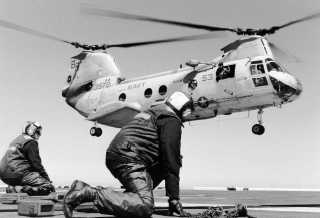side-scan sonar, and the Mk 103 mechanical mine-
sweeping system.
V-22A Osprey
The V-22 Osprey is a joint-service, multimission
aircraft with vertical take-off and landing (VTOL)
capability. It performs VTOL missions as effectively as
a conventional helicopter while also having the
long-range cruise abilities of a twin turboprop aircraft.
The Marine Corps is the lead service in the development
of the Osprey. The Marine Corps version, the MV-22A,
will be an assault transport for troops, equipment and
supplies, and will be capable of operating from ships or
from expeditionary airfields ashore. The Navy’s
HV-22A will provide combat search and rescue,
delivery and retrieval of special warfare teams along
with fleet logistic support transport. The Air Force
CV-22A will conduct long-range special operations
missions.
The Osprey is a tiltrotor aircraft with a 38-foot rotor
system and engine/transmission nacelle mounted on
each wing tip. It can operate as a helicopter when taking
off and landing vertically. Once airborne, the nacelles
rotate 90 degrees for horizontal flight, converting the
V-22 to a high-speed, fuel-efficient turboprop airplane.
The wing rotates for compact storage aboard ship. The
first flight occurred in March 1989. The V-22 is the
world’s first production tiltrotor aircraft. Planned
purchases include 360 for the Marine Corps, 48 for the
Navy, and 50 for the Air Force.
TH-57 Sea Ranger
The TH-57 Sea Ranger is a derivative of the
commercial Bell Jet Ranger 206. Although primarily
used for training, these aircraft are also used for photo,
chase, and utility missions. The Jet Ranger was initially
designed to compete in a U.S. Army light observation
helicopter competition. Bell lost that competition; but,
the 206 was commercially successful. The TH-57 Sea
Ranger provides advanced (IFR) training to several
hundred aviation students a year at Naval Air Station
Whiting Field in Milton, Florida.
8-42
Student Notes:
Figure 8-59.—MH-53E Sea Dragon.

